Vimal Bhatia
Comprehensive Review of Deep Unfolding Techniques for Next-Generation Wireless Communication Systems
Feb 09, 2025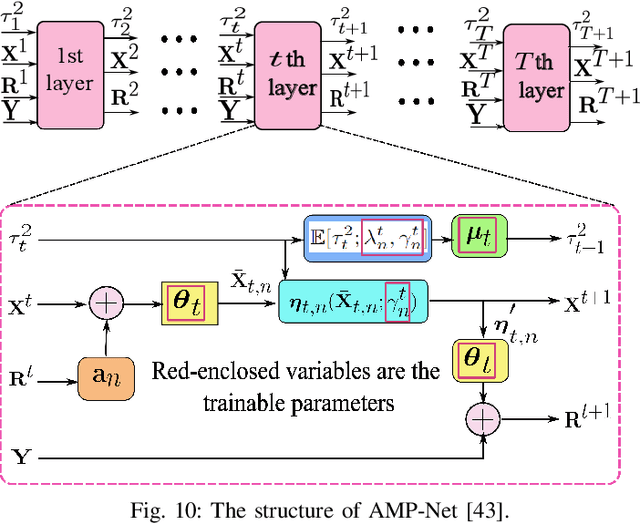
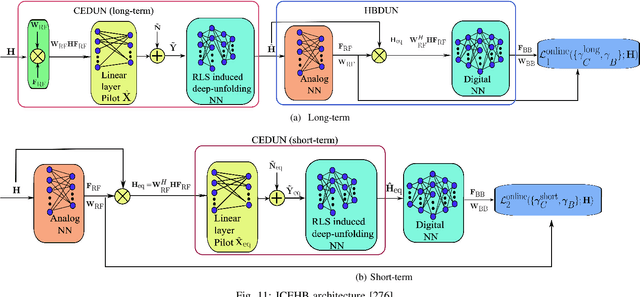
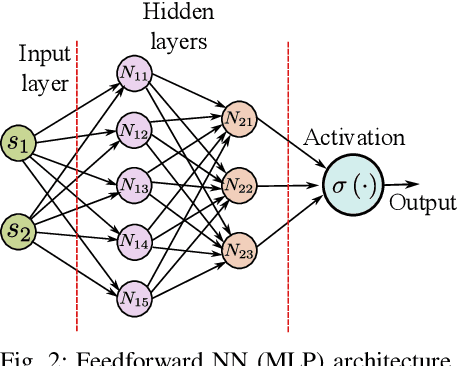
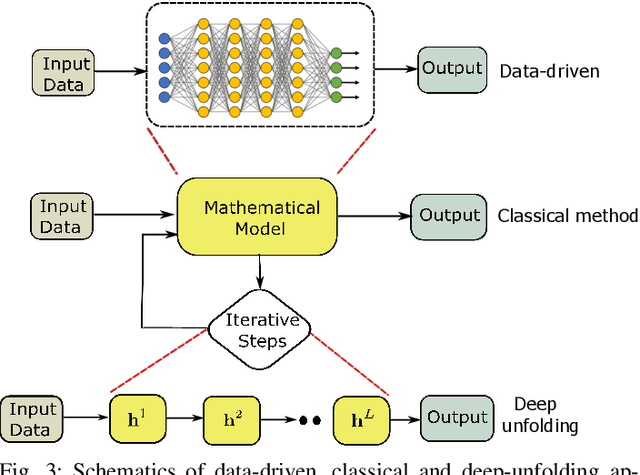
Abstract:The application of machine learning in wireless communications has been extensively explored, with deep unfolding emerging as a powerful model-based technique. Deep unfolding enhances interpretability by transforming complex iterative algorithms into structured layers of deep neural networks (DNNs). This approach seamlessly integrates domain knowledge with deep learning (DL), leveraging the strengths of both methods to simplify complex signal processing tasks in communication systems. To provide a solid foundation, we first present a brief overview of DL and deep unfolding. We then explore the applications of deep unfolding in key areas, including signal detection, channel estimation, beamforming design, decoding for error-correcting codes, sensing and communication, power allocation, and security. Each section focuses on a specific task, highlighting its significance in emerging 6G technologies and reviewing recent advancements in deep unfolding-based solutions. Finally, we discuss the challenges associated with developing deep unfolding techniques and propose potential improvements to enhance their applicability across diverse wireless communication scenarios.
Accurate Closed-Form Solution for Symbol Error Probability in Hexagonal QAM
Oct 03, 2024Abstract:Future communication systems are anticipated to facilitate applications requiring high data transmission rates while maintaining energy efficiency. Hexagonal quadrature amplitude modulation (HQAM) offers this owing to its compact symbol arrangement within the two-dimensional (2D) plane. Building on the limitations of the current approaches, this letter presents a straightforward and precise approximation for calculating the symbol error probability (SEP) of HQAM in additive white Gaussian noise (AWGN) channel. The analytical and simulation results align across several signal-to-noise ratios (SNR). In addition, the proposed approximation is effective for accurately estimating the SEP of HQAM in scenarios with slow-fading, including those subject to Rayleigh fading.
On Performance of Integrated Satellite HAPS Ground Communication: Aerial IRS Node vs Terrestrial IRS Node
Dec 30, 2023



Abstract:With a motive of ubiquitous connectivity over the globe with enhanced spectral efficiency, intelligent reflecting surfaces (IRS) integrated satellite-terrestrial communications is a topic of research interest in an infrastructure-deficient remote terrains. In line with this vision, this paper entails the performance analysis of satellite-terrestrial networks leveraging both aerial and terrestrial IRS nodes, with the support of high altitude platforms over diverse fading channels including shadowed Rician, Rician, and Nakagami-$m$ fading channels. The merits of IRS in enhancing spectral efficiency is analyzed through closed-form expressions of outage probability and ergodic rate. Further, the average symbol error rate analysis for the higher-order quadrature amplitude modulation (QAM) schemes such as hexagonal QAM, rectangular QAM, cross QAM, and square QAM is performed. Practical constraints like antenna gains, path loss, and link fading are considered to characterize the satellite terrestrial links. Finally, a comparison between the high-altitude platforms based IRS node and terrestrial IRS nodes is performed and various insights are drawn under various fading scenarios and path loss conditions. This paper contribute towards understanding and potential implementation of IRS-integrated satellite-terrestrial networks for efficient and reliable communication.
Study of visual processing techniques for dynamic speckles: a comparative analysis
Jun 16, 2021



Abstract:Main visual techniques used to obtain information from speckle patterns are Fujii method, generalized difference, weighted generalized difference, mean windowed difference, structural function (SF), modified SF, etc. In this work, a comparative analysis of major visual techniques for natural gum sample is carried out. Obtained results conclusively establish SF based method as an optimum tool for visual inspection of dynamic speckle data.
On Performance of Energy Harvested Cooperative NOMA Under Imperfect CSI and Imperfect SIC
May 14, 2021



Abstract:With the advent of 5G and the need for energy-efficient massively connected wireless networks, in this work, we consider an energy harvesting (EH) based multi-relay downlink cooperative non-orthogonal multiple access (NOMA) system with practical constraints. The base station serves NOMA users with the help of decode-and-forward based multiple EH relays, where relays harvest the energy from the base station's radio frequency. A relay is selected from the multiple K-relay by using a partial relay selection protocol. The system is considered to operate in half-duplex mode over a generalized independent and identical Nakagami$-m$ fading channel. The closed-form expression of outage probability and ergodic rate are derived for users, under the assumption of imperfect channel state information (CSI) and imperfect successive interference cancellation (SIC) at the receiver node. Expression of outage probability and ergodic rate for both users under the assumption of perfect CSI and perfect SIC are also presented. Further, the asymptotic expression for the outage probability is also shown. The derived analytical expressions are verified through Monte-Carlo simulations.
Finite Dictionary Variants of the Diffusion KLMS Algorithm
Sep 09, 2015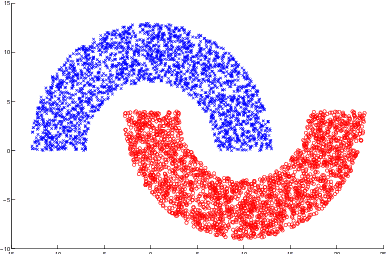
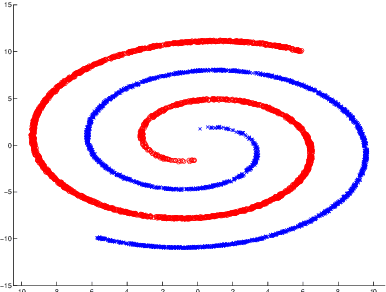
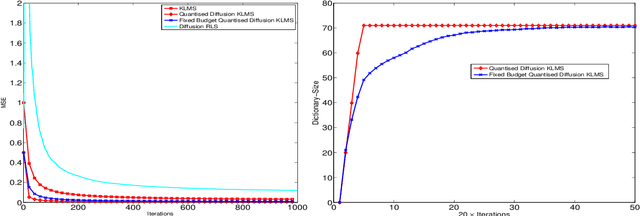
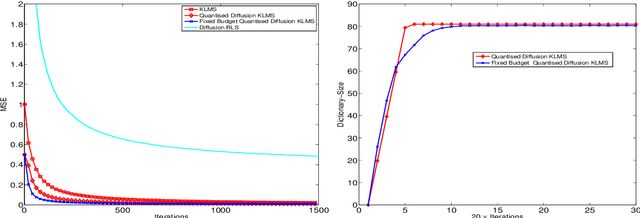
Abstract:The diffusion based distributed learning approaches have been found to be a viable solution for learning over linearly separable datasets over a network. However, approaches till date are suitable for linearly separable datasets and need to be extended to scenarios in which we need to learn a non-linearity. In such scenarios, the recently proposed diffusion kernel least mean squares (KLMS) has been found to be performing better than diffusion least mean squares (LMS). The drawback of diffusion KLMS is that it requires infinite storage for observations (also called dictionary). This paper formulates the diffusion KLMS in a fixed budget setting such that the storage requirement is curtailed while maintaining appreciable performance in terms of convergence. Simulations have been carried out to validate the two newly proposed algorithms named as quantised diffusion KLMS (QDKLMS) and fixed budget diffusion KLMS (FBDKLMS) against KLMS, which indicate that both the proposed algorithms deliver better performance as compared to the KLMS while reducing the dictionary size storage requirement.
Diffusion-KLMS Algorithm and its Performance Analysis for Non-Linear Distributed Networks
Sep 04, 2015
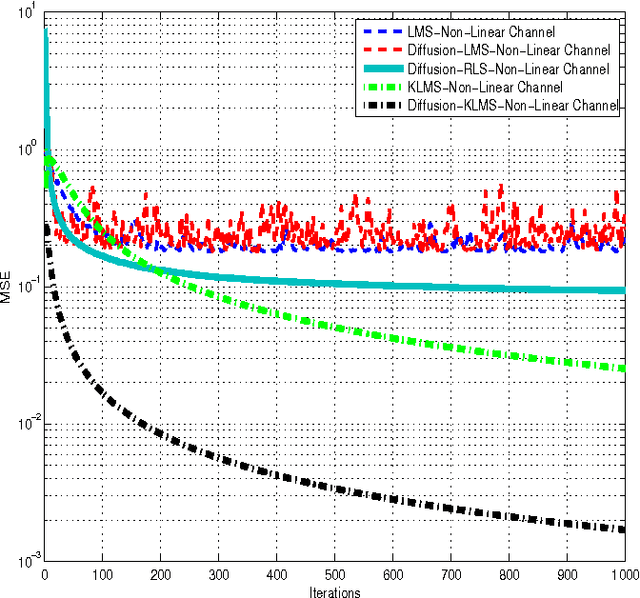


Abstract:In a distributed network environment, the diffusion-least mean squares (LMS) algorithm gives faster convergence than the original LMS algorithm. It has also been observed that, the diffusion-LMS generally outperforms other distributed LMS algorithms like spatial LMS and incremental LMS. However, both the original LMS and diffusion-LMS are not applicable in non-linear environments where data may not be linearly separable. A variant of LMS called kernel-LMS (KLMS) has been proposed in the literature for such non-linearities. In this paper, we propose kernelised version of diffusion-LMS for non-linear distributed environments. Simulations show that the proposed approach has superior convergence as compared to algorithms of the same genre. We also introduce a technique to predict the transient and steady-state behaviour of the proposed algorithm. The techniques proposed in this work (or algorithms of same genre) can be easily extended to distributed parameter estimation applications like cooperative spectrum sensing and massive multiple input multiple output (MIMO) receiver design which are potential components for 5G communication systems.
 Add to Chrome
Add to Chrome Add to Firefox
Add to Firefox Add to Edge
Add to Edge